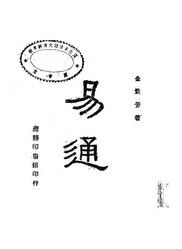File:NLC416-07jh010872-4476 易通.pdf

Original file (770 × 1,056 pixels, file size: 6.97 MB, MIME type: application/pdf, 183 pages)
Captions
Captions
Summary
[edit]| 易通
( |
||||||||||||||||||||||||
|---|---|---|---|---|---|---|---|---|---|---|---|---|---|---|---|---|---|---|---|---|---|---|---|---|
| Author |
金景芳著 |
|||||||||||||||||||||||
| Title |
易通 |
|||||||||||||||||||||||
| Publisher |
商務印書館[發行] (重慶) |
|||||||||||||||||||||||
| Description |
介紹《周易》的知識性著作。作者認為《易經》兆基於伏羲,發展於神農,至周初而造極,經孔子而光大。至秦以卜筮之書未遭火焚,得以保存。漢以後雜異端、穿鑿象數,從而使易晦澀難讀。雖經清代經學者的努力,仍未恢復本意。認為《易經》是「唯物的、積極的、進步的、社會的實證哲學」,並有許多說法與唯物辯證法相符合,並對《易經》給以較高的評價。全書分10章:周易之命名,易學之起源與發展,先哲作易之目的,易之體系,周易之特質,論象數義理,筮儀考,周易與孔子,周易與老子,周易與唯物辯證法。書墨附《再論象數義理》
目錄 |
|||||||||||||||||||||||
| Language | Chinese | |||||||||||||||||||||||
| Publication date | 民國34[1945] | |||||||||||||||||||||||
| Source |
institution QS:P195,Q732353
(民國時期文獻 民國圖書) |
|||||||||||||||||||||||
| 主題 InfoField | 先秦哲學 | |||||||||||||||||||||||
| 中圖分類 InfoField | B221.5 | |||||||||||||||||||||||
| 拼音題名 InfoField | yi tong | |||||||||||||||||||||||
| 載體形態 InfoField | 163頁 | |||||||||||||||||||||||
Licensing
[edit]This image is in the public domain because it is a mere mechanical scan or photocopy of a public domain original, or – from the available evidence – is so similar to such a scan or photocopy that no copyright protection can be expected to arise. The original itself is in the public domain for the following reason:
This tag is designed for use where there may be a need to assert that any enhancements (eg brightness, contrast, colour-matching, sharpening) are in themselves insufficiently creative to generate a new copyright. It can be used where it is unknown whether any enhancements have been made, as well as when the enhancements are clear but insufficient. For known raw unenhanced scans you can use an appropriate {{PD-old}} tag instead. For usage, see Commons:When to use the PD-scan tag. |
| This image contains digital watermarking or credits in the image itself. The usage of visible watermarks is discouraged. If a non-watermarked version of the image is available, please upload it under the same file name and then remove this template. Ensure that removed information is present in the image description page and replace this template with {{Metadata from image}} or {{Attribution metadata from licensed image}}.
Caution: Before removing a watermark from a copyrighted image, please read the WMF's analysis of the legal ramifications of doing so, as well as Commons' proposed policy regarding watermarks. If the old version is still useful, for example if removing the watermark damages the image significantly, upload the new version under a different title so that both can be used. After uploading the non-watermarked version, replace this template with{{Superseded|new filename|version without watermarks}}.Bahasa Indonesia ∙ italiano ∙ eesti ∙ sicilianu ∙ Deutsch ∙ català ∙ magyar ∙ čeština ∙ română ∙ español ∙ português ∙ English ∙ hrvatski ∙ Plattdüütsch ∙ français ∙ Nederlands ∙ polski ∙ galego ∙ slovenščina ∙ suomi ∙ svenska ∙ Ελληνικά ∙ беларуская (тарашкевіца) ∙ български ∙ македонски ∙ русский ∙ українська ∙ മലയാളം ∙ ไทย ∙ 日本語 ∙ 中文 ∙ 中文(简体) ∙ 中文(繁體) ∙ עברית ∙ العربية ∙ فارسی ∙ +/− |
File history
Click on a date/time to view the file as it appeared at that time.
| Date/Time | Thumbnail | Dimensions | User | Comment | |
|---|---|---|---|---|---|
| current | 10:25, 10 June 2023 |  | 770 × 1,056, 183 pages (6.97 MB) | PencakeBot (talk | contribs) | Upload 易通 (1/1) by 金景芳著 (batch task; nlc:data_416,07jh010872,4476; 民國圖書.3; 易通) |
You cannot overwrite this file.
File usage on Commons
The following page uses this file:
Metadata
This file contains additional information such as Exif metadata which may have been added by the digital camera, scanner, or software program used to create or digitize it. If the file has been modified from its original state, some details such as the timestamp may not fully reflect those of the original file. The timestamp is only as accurate as the clock in the camera, and it may be completely wrong.
| Conversion program | Foxit GSDK - Foxit Software Inc. |
|---|---|
| Encrypted | no |
| Page size |
|
| Version of PDF format | 1.7 |





